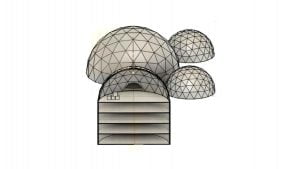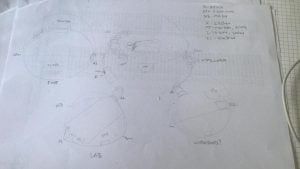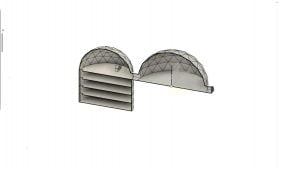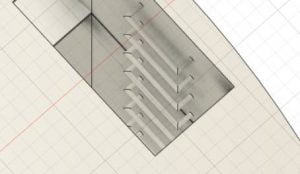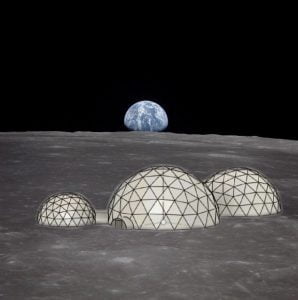Moon Camp Pioneers Gallery 2020-2021
In Moon Camp Pioneers each team’s mission is to 3D design a complete Moon Camp using Fusion 360. They also have to explain how they will use local resources, protect astronauts from the dangerous of space and describe the living and working facilities.
Team: Arcadia
Colégio Valsassina Lisboa Portugal 18, 17
External viewer for 3d project
|
Project description
Our camp joins two virtues required for such a project: it is simple and it is feasible. Unlike other approaches – such as building the entire base inside a cave – our idea is simple enough so it is applicable anywhere on the moonscape, provided it is close enough to the resources we need for the construction and maintenance of the camp – such as water – by covering the camp with moon regolith for an inexpensive, locally produced radiation shielding. Otherwise, the camp provides everything that the crew may need, including recreational areas, a fully equipped medical bay and underground greenhouses. |
|||
|
Where do you want to build your Moon Camp?
Our choice is the Drygalski Crater, located at 79.30°S 84.90°W. We chose this location for two reasons: the fact that water was found in the Cabeus crater (a nearby crater) in 2019 by US LCROSS probe; and the fact that the region is rich in anorthite, a lunar mineral rich in aluminium, useful to build our camp. How do you plan to build your Moon Camp? Describe the techniques and materials you would use.
The construction will take several steps.
The environment on the Moon is very dangerous for the astronauts. Explain how your Moon Camp will protect them.
Our moon camp is airtight, keeping the atmosphere inside stable and using the base nuclear reactor to warm water to keep the temperature steady, we can provide all conditions for life to thrive. Our base will be covered in crushed regolith locally harvested to shield the camp from radiation coming from outer space. If it is required to leave the camp, a double door airlock will be used. When coming inside, a purge routine will clean all moon dust, preventing it from entering the base and contaminating the inside. Explain how your Moon Camp will provide the astronauts with:
|
|||
|
Water
|
Food
|
Electricity
|
Air
|
|
The Cabeus Crater is rich in water, as 2019’s US LCROSS mission proved. Using rovers to find and collect the ice, we can harvest and melt ice which, after purified, can be drunk by the astronauts. Then, pipes protected with super-white painting coats and insulated with aerogel will protect the water from the violent variation of temperature on the moon. |
Our 7-meter radius underground greenhouse is big enough to produce food for our crew. To achieve a healthy diet, our crew will consume 720 grams of potatoes, 90 grams of chickpeas, 85 grams of beans, 327 grams of soybeans, 50 grams of lentils, 200 grams of cabbage, and 190 grams of tomatoes every day. All of which will be produced in the greenhouse. The soil will be a mix of clean moon dust, earth soil and human waste. |
We will use a SMR (Small Modular Reactor) to produce energy with nuclear fuel. The water we will use to cool down the reactor will also be used to warm up the base, preventing us from using a giant amount of energy to keep the temperature comfortable. |
The air will be produced with the same equipment we used to extract aluminium from the rocks. We will be able to electrolyze regolith to collect the oxygen and keep the air breathable. For a crew of 6, we will need about 25 mols of oxygen per day, which is produced by electrolyzing 6kg of regolith every day. |
|
Explain what would be the main purpose of your Moon Camp (for example: commercial, scientific, and/or tourist purposes).
The moon camp will have three main purposes: testing of colonizing equipment for future human outposts in bodies without atmosphere, geological research of the Moon and Earth history and refuelling station to future missions to the outer solar system. |
|||
|
Describe a day on the Moon for your Moon Camp astronaut crew.
Every day, the crew will wake up in the upper level of the main dome. They will have their breakfast while they receive instructions from mission control on the tasks for the day. As the Base commander wakes up, the second official and an engineer- who were awake all night to respond to any problem that may arise – are discharged and go to sleep for eight hours. The remaining four members of the crew receive their daily tasks from Earth and are off to work. The engineers are making a periodic inspection of the rovers, confirming that they are bug-free and all parts are working properly. If the logistics system fails, the entire base will enter contingency mode and reduce activity to a minimum until the problem is fixed. The botanist is checking the status of the crops and soil of the greenhouse, as well as many more experiments that are commissioned by scientists on Earth, such as verifying the development of large plants like trees that were brought from Earth. The geologist went on an EVA the day before to recover new samples from a nearby crater that may be a couple of million years old. They take them to the lab dome and run several tests on the near fifty kilograms of material they brought back in airtight containers. The pilot and the captain are overviewing all systems of the base, like the nuclear reactor and the rovers that are out on missions and controlling spacecraft traffic around the base. They assess the situation of each one of them through a network of polar orbit satellites that are constantly giving high-resolution images of all points of interest in the lunar surface. If any of them gets injured during their tasks, the geologist and the botanist are trained with medical skills to heal minor to medium injuries and even execute small scale surgeries in life or death situation. If there is a lack of knowledge or equipment during such a situation, the crew will be immediately evacuated and taken to Low Earth Orbit where a shuttle will rendezvous with the craft and land the injured crew safely. The craft will then come back to the base and await a replacement to be ready in Low Earth Orbit for pickup. |
|||



